by Evan Randolph
The
Return of Athena--- reclaiming our universal protectress
DRAMATIC
NEW DISCOVERIES:
CONSTANTINE'S TRINITY DOCTRINE INCORPORATED ATHENA AS THE HOLY SPIRIT
ST. AUGUSTINE CONFIRMS MINERVA (ATHENA) AS HOLY SPIRIT
 BACKGROUND ON ROMAN TRINITY- Minerva part of Capitoline Triad-
BACKGROUND ON ROMAN TRINITY- Minerva part of Capitoline Triad-
Built
in 509 BC, the largest temple in Rome
was called Jupiter Optimus Maximus on the Capitoline Hill.(see
footnote 1)
The interior of the temple was divided into three
rooms, dedicated not only to Jupiter but also to his consort Juno
and the
goddess Minerva. Collectively they are known as the Capitoline
Triad, and when Roman power had expanded to encompass an empire,
the central temple of many Roman cities - in Italy and further afield
- was often dedicated to this Capitoline Triad. (see footnote
2)
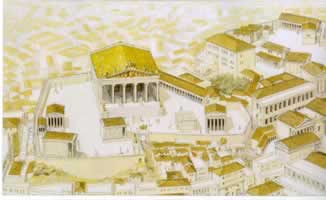
Temple
of Jupiter Optimus
Maximus on Capitoline Hill, Rome-
The Ancient City, Peter Connolly & Hazel Dodge, Oxford Press,
p. 170
Minerva (Athena) was a member of the Roman Trinity
(Capitoline Triad)
500 years prior Christ.
 Constantine
the Great (272-372 CE) believed the Palladium (a statue of
Athena) protected Rome.
Constantine
the Great (272-372 CE) believed the Palladium (a statue of
Athena) protected Rome.
Constantine "diminished none of the priveleges
of the sacred virgins---" Quote from Symmachus references
the late emporer Constantine's policy. (see footnote 3)
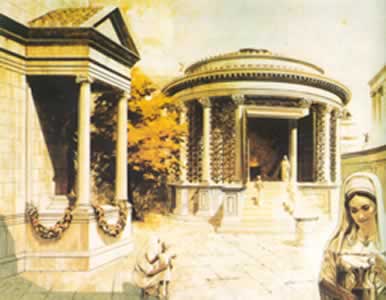
The circular Temple of Vesta- The Ancient City,
Peter Connolly & Hazel Dodge, Oxford Press, p. 172
The priestly office of the College of Vestal Virgins was created by
the second King of Rome. The Vestal Virgins
guarded the Palladium and kept the sacred fire burning. (see
footnote 4)
The Palladium was an image of Pallas Athena
on which the safety of the city depended (see footnote
5),
In Greek & Roman writings, Odysseus and Diomedes stole the Palladium
from Troy and thus
defeated the city. (see footnote 5)
The College of Vestal Virgins ended in 391 CE when disbanded by Theodosius
I. (see footnote 4)
Shortly thereafter, in 410 CE- the Visigoths sacked
Rome (see footnote 6)
Constantine
honors Athena & Nike by placing them above his army on his Arch
commemorating his victory. Constantine defeated Maxentius
at Milvian Bridge in 312 CE. The Arch of Constantine was erected in
315 CE to celebrate this victory. The medallions and copy on this
Arch show Constantine's appreciation of the support of Athena &
Nike in his victory. (see footnote 7)
[THIS IS A NEW FINDING- NOT LISTED ON GOOGLE]
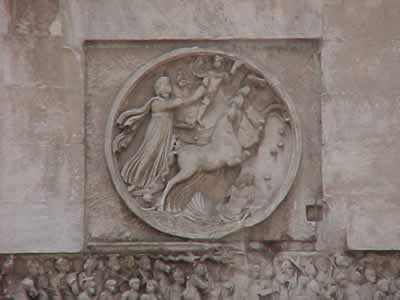
Athena
in chariot with Nike above rising above opposing force. This
medallion appears on Constantine's Arch
directly above scene of Constantine's army leaving Rome to meet Maxentius.
(see footnote 8)
This scene above portrays
the Orphic Hymn to Athena "You driver of steeds... bearing Victory
in your arms!" ( see
footnote 9)
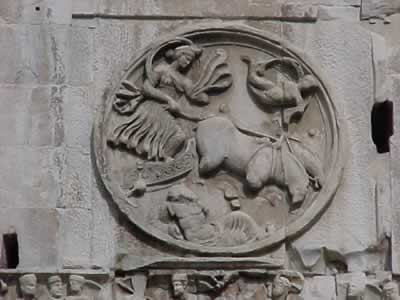
Athena in chariot with Nike above coming down on opposing
force. This medallion appears directly above
scene of Constantine's army (after victory over Maxentius) entering
Rome in triumph. (see footnote 8)
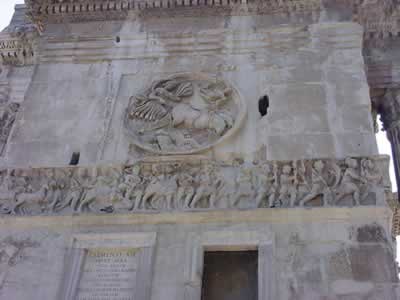
Here is the complete
scene showing Athena & Nike directly above Constantine's
army
entering Rome in triumph, Constantine in his chariot on the left.
(see footnote 10)
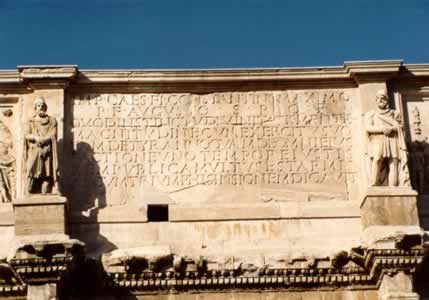
Constantine
honors Athena goddess of wisdom when he states on his Arch
(lines 3 & 4 above):
"...quod instinctu
divinitatis mentis magnitudine..."
this translated: "...since
through divine inspiration and great wisdom..."
(for inscription- see footnote 8, translation- see footnote 11)
In
330 CE Constantine moved his seat of government from Rome to
Byzantium, later called Constantinople. (see footnote
12)
Constantine the Great erected the first church of Hagia
Sophia (Divine Wisdom) in Byzantium.(see footnote 13)
Few structures remain of Constantine's Byzantium except a huge column
which he erected.(see footnote 14)
This column stands 120 feet high. Constantine topped it with a colossal
bronze statue of Apollo, supposedly the work of Phidias. Underneath
this pillar, it is said that Constantine
had buried the Palladium which he had removed from Rome.
(see footnote 15)

Constantine's 120 foot column in Constantinople with the Palladium
buried underneath. (see footnote 16)
Constantine
in 325 CE presided over the Council of Nicea. The significant
result of this Council was the adoption of the doctrine of the Trinity.
Christianity used the thinking of Plato to formulate its Trinity
doctrine. (see footnote 17)
As the learned trinitarian historian Mosheim states concerning Origen
and the Platonizing movement 200-250CE:
"A new class of philosophers had grown up in Egypt ...they much
preferred Plato, and embraced most of his dogmas concerning
God, the human soul, and the universe." (see footnote 17)
"The Christian bishops introduced, with but slight alterations,
into the Christian worship, those rites and institutions by which
formerly the Greeks and Romans and others had manifested their piety
and reverence toward their imaginary deities; supposing that the people
would more readily embrace Christianity if they perceived the rites
handed down to them from their fathers still existing unchanged among
the Christians, and saw that Christ and the martyrs were worshipped
in the same manner as formerly their gods were." (see footnote
17)
"There was, accordingly, little difference in these times between
the public worship of the Christians and that of the Greeks and Romans."
(see footnote 17)
"It will be noted ... that the most distinguished "Christian"
teachers of the 4th century looked to Origen and the Platonic
philosophy as their model. Any doctrines therefore - such
as the Trinity - formulated at this time are bound to be more
pagan than Christian." (see footnote 17)
Plato speaks of 3 specific Gods--
We read in Plato's Euthydemus a dialog between Socrates and
Dionysodorus:
"No matter, said Dionysodorus, for you admit that you have
Apollo, Zeus, and Athene.
Certainly, I said.
And they are your Gods, he said.
Yes, I said, my lords and ancestors." (see footnote 18)
Therefore Plato identifies Zeus,
Apollo & Athena as his Trinity.
Additional
Findings ref Constantine:
1)- Constantine's Holy Spirit is gender
neutral -- Click for additional information
2)- Evidence that Holy Spirit is feminine
-- Click for additional
information
3)- Evidence that Athena was Constantine's
Holy Spirit--- Click here
 St. Augustine (354-430 CE) confirms
Minerva (Athena) as the Holy Spirit-
St. Augustine (354-430 CE) confirms
Minerva (Athena) as the Holy Spirit-
 St Augustine became
Bishop of Hippo in Africa in 395 CE. After the sack of Rome in 410
CE, "boatloads of upper-class Romans fled the Eternal City for
North Africa....thus began a rebirth of a sophisticated philosophical
paganism that leaned heavily on the writings of Plotinus and
Porphyry--Augustine's old friends from his former life of philosophy."
(see footnote 19)
St Augustine became
Bishop of Hippo in Africa in 395 CE. After the sack of Rome in 410
CE, "boatloads of upper-class Romans fled the Eternal City for
North Africa....thus began a rebirth of a sophisticated philosophical
paganism that leaned heavily on the writings of Plotinus and
Porphyry--Augustine's old friends from his former life of philosophy."
(see footnote 19)
St Augustine in 413 CE wrote The City of God, "his primary
audience was those who were turning to philosophy or to a literary
paganism, blaming Christianity for the fall of Rome." (see footnote
19)
He argued that
neither Rome nor Troy perished because they lost Minerva.
The City of God, Book
I, Chapter 2
 St Augustine
writes concerning Plato's comments on Minerva: "another
the patterns of things, which Plato calls ideas. He makes Jupiter
to signify heaven, Juno the earth, Minerva the ideas. ....
But, with respect to the last, I am forgetting to say that Plato attributed
so great an importance to these ideas as to say, not that anything
was made by heaven according to them, but that according to them heaven
itself was made".[1] his footnote "In
the Timæus".
St Augustine
writes concerning Plato's comments on Minerva: "another
the patterns of things, which Plato calls ideas. He makes Jupiter
to signify heaven, Juno the earth, Minerva the ideas. ....
But, with respect to the last, I am forgetting to say that Plato attributed
so great an importance to these ideas as to say, not that anything
was made by heaven according to them, but that according to them heaven
itself was made".[1] his footnote "In
the Timæus".
The City of God, Book
VII, Chapter 28
St Augustine places Minerva as third member of Plato's
Trinity.
 St Augustine comments on the
views of his two pagan friends Plotinus (204-270 CE)
and Porphyry (232-303
CE) as to their views on Platonist "principles" or Trinity
(see also footnote below).
St Augustine comments on the
views of his two pagan friends Plotinus (204-270 CE)
and Porphyry (232-303
CE) as to their views on Platonist "principles" or Trinity
(see also footnote below).
"For Plotinus
places the soul of nature after the intellect of the Father, while
Porphyry, making it the mean, does not place it after, but between
the others. No doubt he spoke according to his light, or as he thought
expedient; but we assert
that the Holy Spirit is the Spirit not of the Father only, nor of
the Son only, but of both. For philosophers
speak as they have a mind to, and in the most difficult matters do
not scruple to offend religious ears; but we are bound to speak according
to a certain rule, lest freedom of speech beget impiety of opinion
about the matters themselves of which we speak."
The City of God, Book
X, Chapter 23
A footnote on Platonist "principles" states:
"The Platonists of the Alexandrian and Athenian
schools, from Plotinus to Proclus, are at one in recognizing in
God three principles or hypostases: 1st, the One or the Good,
which is the Father; 2nd, the Intelligence or Word, which is the Son;
3rd, the Soul, which is the universal principle of life. But as to
the nature and order of these hypostases, the Alexandrians are
no longer at one with the school of Athens. On the very subtle
differences between the Trinity of Plotinus and that of Porphyry,
consult M. Jules Simon, ii. 110, and M. Vacherot, ii. 37.—Saisset".
The City of God, Book
X, Chapter 23
St Augustine identifies the Holy Spirit as the third
member of the Platonist Trinity, thereby re-naming Plato's Minerva
as the Holy Spirit.
 Conclusion-
As St Augustine confirms that the Trinity has Platonic roots, and
that Minerva was in Plato's Trinity, he thereby supports our contention
that Constantine incorporated Athena/Minerva as the Holy Spirit.
Conclusion-
As St Augustine confirms that the Trinity has Platonic roots, and
that Minerva was in Plato's Trinity, he thereby supports our contention
that Constantine incorporated Athena/Minerva as the Holy Spirit.
 Author's comment-
Author's comment-
Shortly after St Augustine finished his magnum opus THE CITY OF GOD,
in which he compared a peace-loving Christ-centered city to that
evil city called Rome, Christians ran rampant trying to obliterate
everything pagan.
Pagan temples were demolished, pagan priests were killed, Athena's
gold statue in the Parthenon was destroyed, pagan books and the massive
library at Alexandria were burned. The world plunged into the Dark
Ages, culminating in the Crusades and the Inquisition in which
millions were killed.
500 years prior to Christ, the pagan Pythagoras taught that the
earth was round and introduced the concept of "antipodes",
the idea that people on the other side of the earth were walking on
the surface upside down in relation to us. (see footnote 20)
The early Christian church Fathers preached that the earth was flat,
following Biblical teachings that the earth had 4 corners.
(see footnote 20)
We note that St Augustine in THE CITY OF GOD book XVI chapter 9 argues:
"But as to the fable that there are Antipodes, that is
to say, men on the opposite side of the earth, where the sun rises
when it
sets to us, men who walk with their feet opposite ours, that is
on no ground credible. And, indeed, it is not affirmed that this
has been learned by historical knowledge, but by scientific conjecture...yet
it does not follow that the other side of the earth is bare of water;
nor even, though it be bare, does it immediately follow that it is
peopled. For Scripture, which proves the truth of its historical
statements by the accomplishment of its prophecies, gives no false
information; and it is too absurd to say, that some men might
have taken ship and traversed the whole wide ocean, and crossed from
this side of the world to the other, and that thus even the inhabitants
of that distant region are descended from that one first man."
Such misinformation prevailed.
The science and wisdom of the Greeks was attacked, and despite the
fact people like St Augustine had borrowed pagan thinking, church
fathers like St John Chrysostom (344-408 CE) bragged about how they
had successfully silenced Greek thinkers like Plato & Pythagoras.
(see footnote 20)
Not until the Renaissance did the world slowly begin to rediscover
what they once knew. The church finally realized the world was
round, as was known by the pagan Pythagoras in 500 BC.
Possibly the church will one day rediscover what Constantine &
St Augustine knew, that Minerva/Athena was the original Holy Spirit
named in Constantine's Nicene Creed.
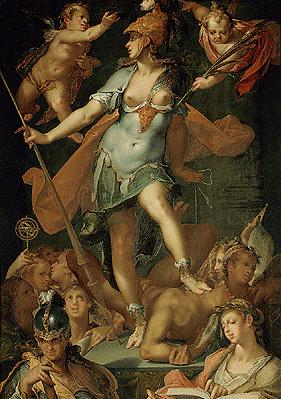
MINERVA VICTORIOUS OVER IGNORANCE by Bartholomeus Spranger C. 1591
(see footnote 21)
"Bartholomeus' painting
"Wisdom Conquers Ignorance" carries an appropriate theme
for the time in history in which the artist
was painting. The Renaissance was a time period literally named for
the "rebirth" of knowledge from the ignorance of the
Middle Ages. The Muses are also shown in the picture with Athena because
the Renaissance did not just overcome the
ignorance of math and science, but also of literature, music, and
art." (see footnote 22)
 The Athena statue in the Parthenon was huge and in place for
The Athena statue in the Parthenon was huge and in place for
867 years (until destroyed by Christians).
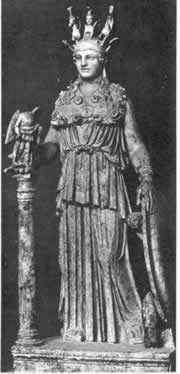
Athena Parthenos, Greek goddess of Wisdom. (Parthenos
means Virgin). This statue reproduces, with a slight variation in
posture, the celebrated Athena Parthenos by Phidias in the Parthenon.
The huge statue, approx. 42 feet tall, dominated the interior
of the Parthenon in Athens, Greece. She held a shield upright
with a snake coiled within it; the other hand held a Nike (Victory).
Phidias' massive statue of Athena stood in the Parthenon 438 BCE until
429 CE, a total of 867 years.The reproduction above is 2nd
century CE. Athens Museum. New Larousse Encyclopedia
of Mythology, p. 107
Athena's dress was covered in gold,
the value of which in today's dollars would be $12,000,000.
(see Footnote 23)
 Here
is a full sized reproduction of Athena-
Here
is a full sized reproduction of Athena-
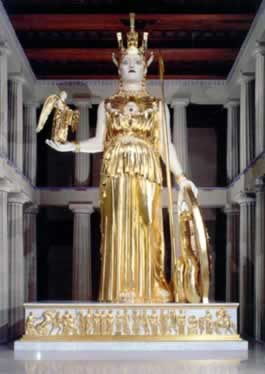
This
full-scale replica of Athena Parthenos, Greek goddess of Wisdom,
is 41 feet 10 inches tall and weighs 12 tons. The goddess of
victory (Nike) in Athena's right hand is 6 feet 4 inches tall. (see
Footnote 24 ref Athena statue)
Located in Nashville, TN, Athena Parthenos is the centerpiece of a
full scale replica of the ancient Parthenon.
(see Footnote 25 ref Parthenon, Nashville)
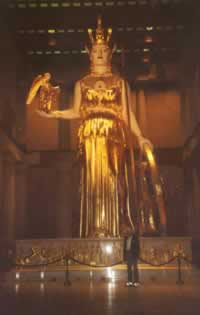
Here is Evan Randolph
(lower right) standing in front of 42 foot statue of Athena
in the Parthenon, Nashville. Note how Evan's Nike sneakers lit up
for the occasion.
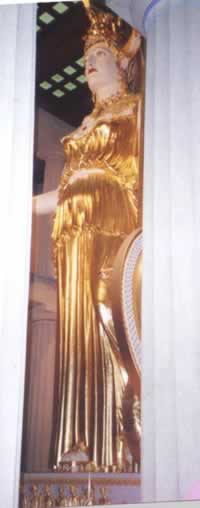
42 foot Athena
as seen from the side between the pillars of the Parthenon, Nashville.
 IN
ANCIENT GREECE- ATHENA, GODDESS OF WISDOM, WAS WELL KNOWN-
IN
ANCIENT GREECE- ATHENA, GODDESS OF WISDOM, WAS WELL KNOWN-
 Plato
(429-348 BCE) states that the Goddess Athena is both "...a
lover of war and a lover of wisdom..." (see Plato Timaeus
24d- footnote 26).
Plato
(429-348 BCE) states that the Goddess Athena is both "...a
lover of war and a lover of wisdom..." (see Plato Timaeus
24d- footnote 26).
Plato Cratylus 407a-b - "The ancients seem to have had
the same belief about Athena as the interpreters of Homer
have now; for most of these, in commenting on the poet, say that he
represents Athena as mind (nous) and intellect (dianoia); and
the maker of names seems to have had a similar conception of her,
and indeed he gives her the still higher title of "divine
intelligence" (hê theou noêsis), seeming to
say: This is she who has the mind of God (Theonoa)..."
(see footnote 26)
Plato wrote about wisdom in a female
context; she can be found in all her purity in the other world, where
the souls go after death. (Plato, Phaedo, The Harvard Classics
1909, p. 57)
 800 BC- The
Greek goddess of Wisdom Athena appeared 162 times in HOMER'S
ODYSSEY. She came down from heaven and provided significant help
to Odysseus in his earthly travails. (see footnote 27)
800 BC- The
Greek goddess of Wisdom Athena appeared 162 times in HOMER'S
ODYSSEY. She came down from heaven and provided significant help
to Odysseus in his earthly travails. (see footnote 27)
It is interesting that Athena & Odysseus planned the recovery
of Odysseus's wife and home on Apollo's grand festal day (Odyssey
20:307). This change around of Odysseus's fortunes, long in decline
and now on the upswing, occured at the Winter Solstice, then December
25th--Apollo's festal day! (see Footnote 28).
Apollo was a sun god, a healer-god, the god of divination and
prophecy, shepherd-god, in addition to archer-god
(New Larousse Encyclopedia of Mythology- pg 113) and was born on December
25th, the winter solstice.
[NEW DATA]-- Jewish-Hellenic
Biblical writers incorporated Homer's Odyssey directly into
the Wisdom of Solomon 4:10 - 5:22 (in
the Septuagint)
Athena, Greek goddess of wisdom,
who played such a key role in saving Odysseus in the Odyssey,
now reappears as Divine Wisdom in the Jewish-Hellenic Wisdom texts.
Click for supporting documentation--[THIS
IS A NEW FINDING- NOT LISTED ON GOOGLE]
CONLUSION REF WISDOM TEXTS:
JEWISH-HELLENIC DIVINE WISDOM = ATHENA, GREEK GODDESS
OF WISDOM
"Christian antipathy to paganism is ungrateful,
since it derives every element of its theology, ritual and symbolism,
along with its sacred scriptures, from that source; it reconstructed
its entire dogma over the model of pagan, that is, of Platonic and
Aristotelian philosophy; it has perpetuated the celebration of most
of the pagan religious festivals; and, finally, it has adopted, as
its own policy, the pagan emphasis on esotericism." See footnote
29
 Early
Christians destroy Athena's statue in the Parthenon in 429 CE
Early
Christians destroy Athena's statue in the Parthenon in 429 CE
Athena installed in her Temple the Parthenon in Athens in 438
BCE, atop the Acropolis. (see footnote 30)
Athena remained enshrined inside the Parthenon until 429 CE (a total
of 867 years), when "The Temple of Goddess Athena (Parthenon)
on the Acropolis of Athens is sacked." (see Footnote 31)
"The Christians, under the emperor Theodosius II, removed
the statue to Byzantium, where it was stripped of its
gold and destroyed without a trace." (see Footnote 32)
Statement 5
 527-565
CE- CHRISTIAN ROMAN EMPEROR JUSTINIAN
(RULING FROM CONSTANTINOPLE) EMBRACED CLASSICAL GREEK THINKING---he
rebuilt the magnificant church Hagia Sofia (Divine Wisdom) in Constantinople
which was described at the time using thinly veiled references to
Athena.
527-565
CE- CHRISTIAN ROMAN EMPEROR JUSTINIAN
(RULING FROM CONSTANTINOPLE) EMBRACED CLASSICAL GREEK THINKING---he
rebuilt the magnificant church Hagia Sofia (Divine Wisdom) in Constantinople
which was described at the time using thinly veiled references to
Athena.
Click here for supporting documentation
 630
CE- ATHENA'S TEMPLE NAMED AFTER DIVINE WISDOM--
630
CE- ATHENA'S TEMPLE NAMED AFTER DIVINE WISDOM--
"The most important symbol of Greek heathenism, the Parthenon,
was changed in the seventh century into a church for Aghia Sophia,
the divine wisdom..."
(see footnote 33)
This shows beyond any doubt that the Christian
Church linked Divine Wisdom to Athena.
"It is by no means coincidence that the chief temples of Pagan
Athens and Christian Constantinople were both dedicated to Wisdom.
The Parthenon as the shrine of the Goddess Athena, Goddess of Wisdom,
and Justinian's Great Church both showed respect for "Sophia"
which has always been one of the chief traits of the Greek mind."
(see footnote 34)
The
Return of Athena--- reclaiming our universal protectress
CONSTANTINE'S
TRINITY DOCTRINE INCORPORATED ATHENA AS THE HOLY SPIRIT
ST.
AUGUSTINE CONFIRMS MINERVA (ATHENA) AS HOLY SPIRIT
FOOTNOTES:
Footnote 1
http://en.wikipedia.org/wiki/Jupiter_(god)
Footnote 2
http://www.bbc.co.uk/history/ancient/romans/roman_religion_gallery_02.shtml
Footnote 3
http://encyclopedia.laborlawtalk.com/Constantine_I_(emperor)
Footnote 4
http://en.wikipedia.org/wiki/Vestal_Virgin
Footnote 5
http://en.wikipedia.org/wiki/Palladium_%28mythology%29
Footnote 6
http://www.musesrealm.net/rome/timeline.html
Footnote 7
http://www.architectour.com/1.htm
Footnote 8
http://myweb.lmu.edu/fjust/Rome-ArchConst.htm
Footnote 9
http://www.commonplacebook.com/inspire/athena/hymns.shtm
Footnote 10
http://www.historyforkids.org/learn/romans/art/archconstantine.htm
Footnote 11
http://sights.seindal.dk/sight/299_Arch_of_Constantine-2.html
Footnote 12
http://www.yasou.org/byzantium/byz.htm
Footnote 13
http://www.sisantours.com/hag_sop.html
Footnote 14
http://www.omhros.gr/Kat/History/Rel/Mos/Istanbul.htm
Footnote 15
http://gd.cnread.net/cnread1/ewjd/g/gibbon/hor/065.htm
Footnote 16
http://www.geocities.com/constantine325ist/early.html
Footnote 17
http://www.antipas.org/books/trinity/trinity1.html
Footnote 18
http://www.gutenberg.org/dirs/etext99/uthyd10.txt
Footnote 19
http://www.chroniclesmagazine.org/Chronicles/December2002/1202Wolf.html
Footnote 20
http://www.ethicalatheist.com/docs/flat_earth_myth_ch5.html
Footnote 21
http://www.goddess-athena.org/Museum/Paintings/index.htm
Footnote 22
http://www.cornellcollege.edu/classical_studies/myth/athena/index2.html
Footnote 23
http://www.perseus.tufts.edu/cl135/Students/Colin_Delaney/fathena.html
Footnote 24 for Athena statue replica Nashville
http://www.nashville.gov/parthenon/athena.htm
Footnote 25 for Nashville Parthenon replica
http://www.nashville.gov/parthenon/index.htm
Footnote 26
http://www.goddess-athena.org/Museum/Texts/Plato_x.htm
Footnote 27
http://www.goddess-athena.org/Museum/Texts/Odyssey.htm
Footnote 28
http://www.hermes3.net/dec404.htm
Footnote 29 (see quote near end)
http://www.theosophical.org/theosophy/books/rebirth/ch6.html
Footnote 30
http://www.goddess-athena.org/Museum/Temples/Parthenon/index.htm
Footnote 31
http://www.wcer.org/members/europe/Greece/persec.htm
Footnote 32 (see modern date: Dec 4th)
http://www.personal.psu.edu/users/w/x/wxk116/RomanCalendar/dec01.htm
Footnote 33 (para 2)
http://monolith.dnsalias.org/~marsares/acro/history/medieval.html
Footnote 34 (see "The Church of St. Sophia")
http://www.yasou.org/byzantium/byz.htm
Footnote 35
http://en.wikipedia.org/wiki/Nicene_Creed
Footnote 36
http://www.piar.hu/councils/ecum02.htm
Footnote 37
http://www.kencollins.com/why-07.htm
Footnote 38
http://www.earlychristianwritings.com/text/gospelhebrews-throck.html
Footnote 39
http://www.bible-researcher.com/eusebius.html
Footnote 40
http://www.geocities.com/kibotos2002/feminine.html
Footnote 41
http://bama.ua.edu/~ksummers/cl222/LECT2/tsld002.htm
Footnote 42 (see para 5)
http://www.bellaonline.com/articles/art8904.asp
Footnote 43 (see Orphic Mysteries)
http://www.geoman.com/jim/ancientmystery.html
Footnote 44 (see "Literature and the Arts", near bottom)
http://www.greece.org/Romiosini/constple.html
Footnote 45 (see "Literature and the Arts", nearer bottom)
http://www.greece.org/Romiosini/constple.html
Footnote 46
http://86.1911encyclopedia.org/P/PA/PAULUS_SILENTIARIUS_.htm
Footnote 47
http://www.fordham.edu/halsall/source/paulsilent-hagsoph1.html
Contact Evan by
email
Evan's
web site on the Holy Spirit - Divine Feminine-











